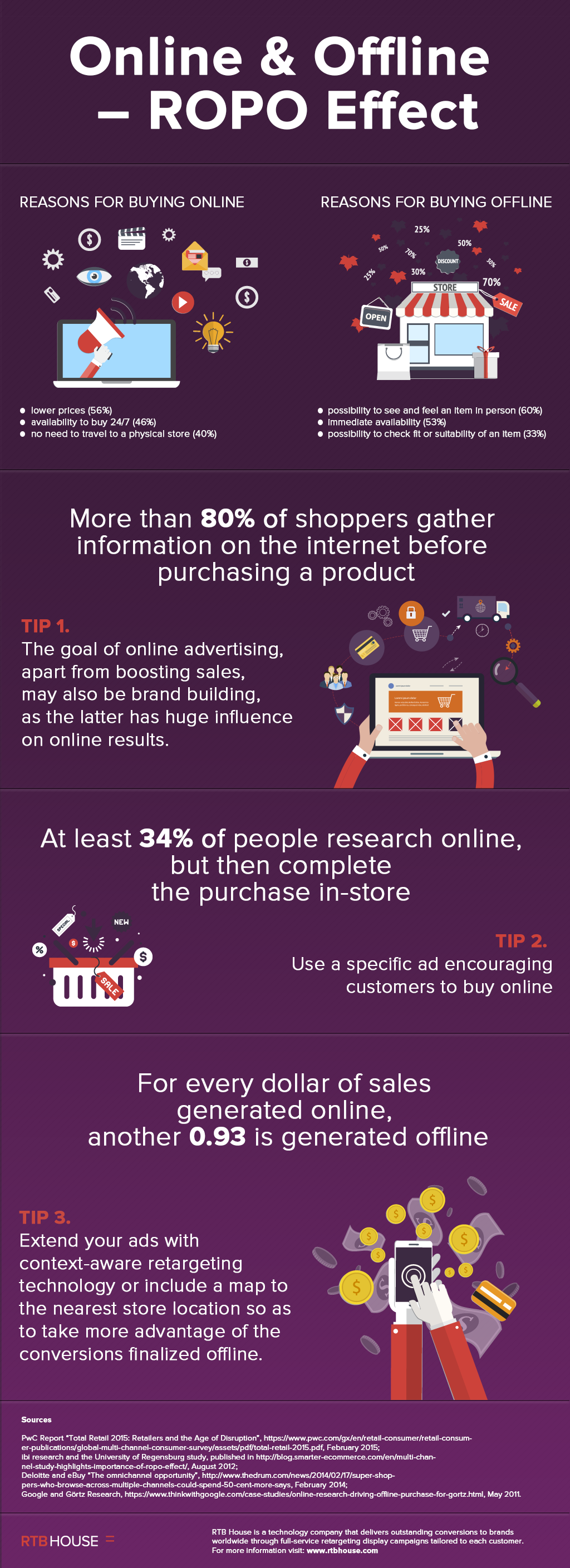In the era of internet and social media technology, online advertising is simply a must for any brand or business. The fact that an ad can multiply returns on investment is obvious, but how exactly do new online advertising solutions influence offline buyers’ behaviours?
From online to offline
According to PwC’s “Retailers and the Age of Disruption” report, most shoppers who buy online do so because of lower prices (56%) and higher availability to buy (46%). When traditional shops can convince customers to see, touch and try out products, buyers decide to buy offline for an opportunity to have the product in their hands immediately (53%). So, from a traditional standpoint, offline and online marketing activities are clearly two different ways to approach potential clients which require different techniques and tools to reach the audience.
However, in many cases activities taken in the virtual world can influence buyers’ decisions in brick-and-mortar shops. Your online shop will often act as a catalogue of your products, for people to check out your offer, regardless if they eventually decide to buy offline or online.
So, online ads can be a crucial starting point of the buying path with the final purchase made in a physical store. A smart strategy regarding those will help to use the full potential of your business.
Buying pathways
Let’s assume that you are about to buy a new pair of running shoes. It’s more than likely that, before deciding on a model, you’ll check around for more options online. And then, because of personal preferences, you might want to check whether this particular model suits you by visiting a sports store to try it out.
When you are finally in the shop, and the price is comparable to what you researched online, you can buy it with confidence. A more common example of such buying behaviours is car shopping. Nowadays, most buyers compare models on the internet, but will not decide to buy a specific one without a test drive.
This is the ROPO (research online, purchase offline) effect and it is being recognised more and more as a powerful e-commerce buying pathway. A study by IBI and the University of Regensburg on multichannel distribution confirmed this trend by highlighting the importance of the internet for buyers. It shows that more than 80% of shoppers gather information on the internet before purchasing a product.
This has deep implications for modern buying behaviours – it suggests that the process of searching influences the decision to buy a product. According to a report from Deloitte and eBay, “The omnichannel opportunity”, at least 34% of people research online, but then complete the purchase in-store. Marketers use ROPO effect to great lengths when choosing online campaigns and retargeting tools.
Tip 1: The goal of online advertising is not always online sales, but also brand building which will influence results offline.
Direct response ads will have a branding effect even if it’s hard to measure. Although the creative’s main goal is to drive potential shoppers into the purchase funnel, the website’s logotype and other brand elements will have their influence on its recognition and perception among users shown the ads. Rooting the brand within the user’s range of choices is crucial both to online and offline sales channels.
A more complex retargeting scenario will give us the option to display special creatives, for example, to those users who abandoned their basket several times. If they don’t want to buy online, marketers must use the opportunity to help improve the brand image for later revenue by displaying a static creative aimed at awareness.
Tip 2: Use a specific ad that will encourage people to buy offline.
When product searches are done online, knowledge about products is acquired, but sales are seldom finalised from start to finish on a computer screen. This is the case of many stores that sell high price point goods, such as construction equipment, large furniture, electronics, etc. The goal for these brands is to use the online channel to drive in-store sales.
One way to do this is to offer a special creative aimed at offline purchasing. Show them the furniture they were looking for and direct them to a consultant or offer a discount. For warehouses that sell large goods like construction equipment and furniture, show them exactly what it looks like on the shelves or in-store.
Tip 3: Add context-aware retargeting technology or display a map to the nearest store location straight on the ad.
A potential buyer may not know there’s a location that sells your products nearby. Retargeting tools can help reach each user with a localised ad that informs them of nearby store locations. Taking it a step further, take a chance and display a discount code or bonus offers local to that shop.
Bringing results
According to a study conducted by Google and Görtz, sales revenues from customers who performed ROPO are disproportionately high.
For every dollar of sales generated online, another $0.93 is generated offline. It’s worth remembering that when thinking about return on investment in advertising your online activities can bring results not only in the e-shop, but also influence sales in traditional brick-and-mortar stores.


